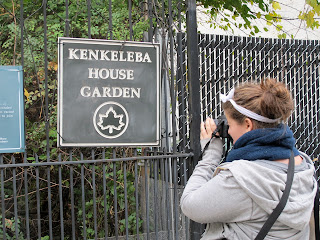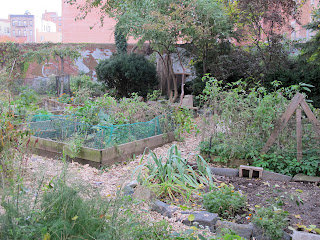On Thursday, November 17th, the Food Politics clan was paid a visit by a very kind herbalist under the name of Isa Brito. She is the mother of a student here at BHSEC, and so she came prepared with plenty of natural stress-relievers, all of which I will address in just a minute.
As a prelude to our evening of witchcraft and wizardry, Isa first explained to the class that many people neglect their local and natural medicinal resources for big-brand products like Tylenol and Advil for the simple reason that we don't know such resources exist. It is also a common misunderstanding that GOOD herbal medicine is expensive and must be imported from other countries (Australia for tea tree oil, or Hawaii for Kava Kava), when in fact, they are right under our feet. I have provided summaries of our experiences with two of the herbs me had the privilege of learning about during Isa's visit.
OAT STRAW: The first of the herbs examined and tested, Oat Straw is a leafy stalk that can be consumed at any time of the day, regardless of your emotional whereabouts, and can easily substitute water when mixed properly and proportionally. Oat straw is good for just about everything; from skeleton to muscle, Oat Straw helps to build up the Nervous system against stress (grrr...), keeping us strong, healthy and happy. To create a magical Oat Straw remedy, you need one other ingredient, aside from the herb itself: water. First you might need to take a trip to the local hardware store to pick up the quart size glass jar that is crucial to the making of this tasty and nutritious drink. After that, add approximately 10g of Oat Straw to the jar, and fill it with water (I've included a list of resources that Isa recommended as a means of purchasing a personal supply of Oat Straw). Lastly, the straw must be left to soak for at least four hours so that the nutrients (calcium, phosphorus, potassium, B complex, Vitamin A and Vitamin C) can leave the plant. After the Hay Straw has soaked, filter the mixture of its chunky bits and it's ready to go.
KAVA-KAVA: Kava Kava is a muscle relaxer. It is good to drink as a tea, in smaller quantities rather than larger, for the reason that "It will make you feel like Jell-O", as Isa so accurately stated. Last Friday when I was young and stupid, I took it upon myself to test this theory, and consumed three cups of Kava tea, underestimating the suggestion that one is enough. At one point i found it impossibly difficult to form words, however the satisfying taste coaxed me further into my herbal adventure. Kava Kava tea can be made by filling a DIY tea bag with around 1.5 teaspoons of the herb in a cup of hot water. Might I add that the tea is especially scrumptious with a spoonful of Blue Agave Nectar, which adds a heavenly sweetness to the concoction.
After learning about the herbs above, as well as Lemon Balm, Chamomile, Rosemary, and many others, Isa concluded the evening with the distribution of goody bags (herb samples) to all contenders.
Lastly, here are two websites Isa provided if anyone needs a place to purchase their herbs.
www.mountainroseherbs.com
www.jeansgreens.com
Some shops Isa thought you might like to visit are...
Flower Power-- East 9th street off 1st avenue
Herb Shoppe--Atlantic Avenue, Brooklyn
-Francesca Craft
















